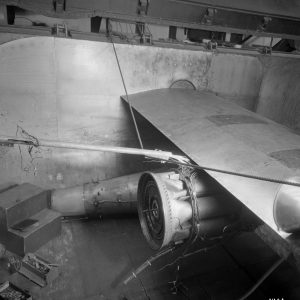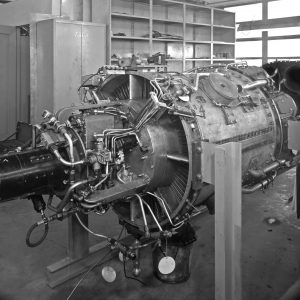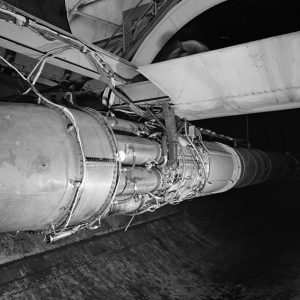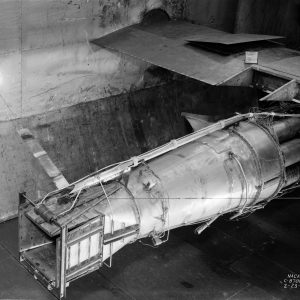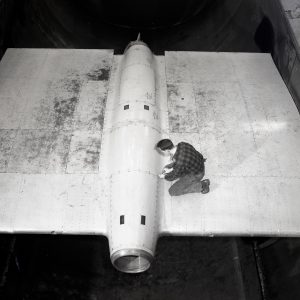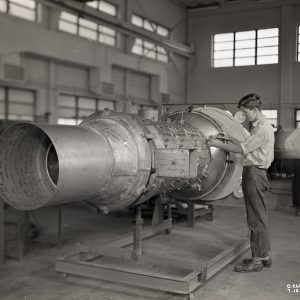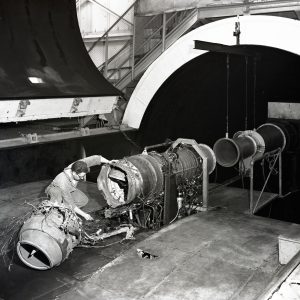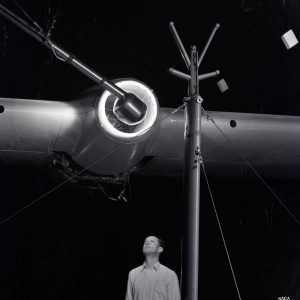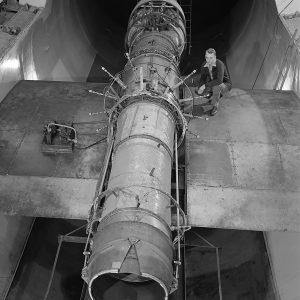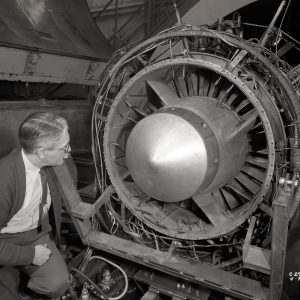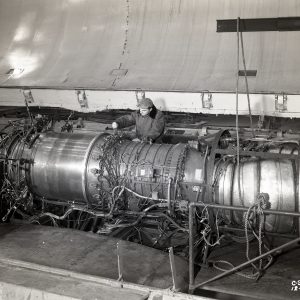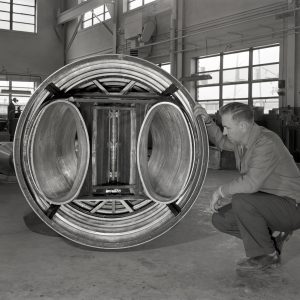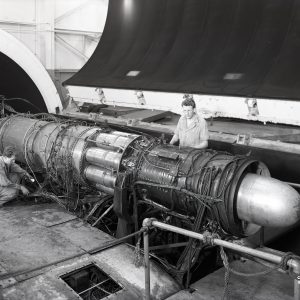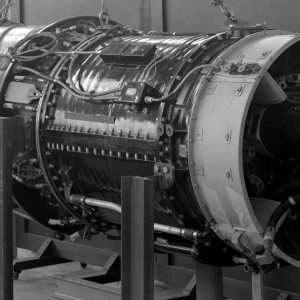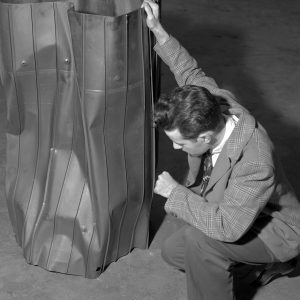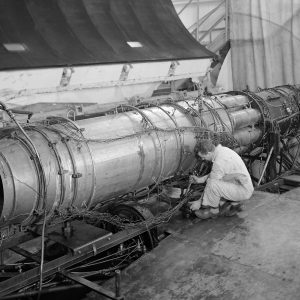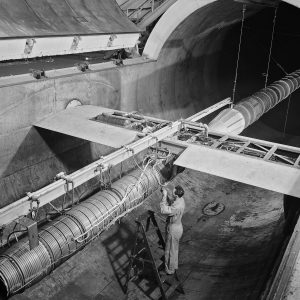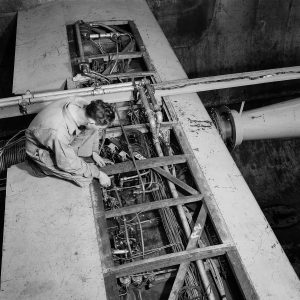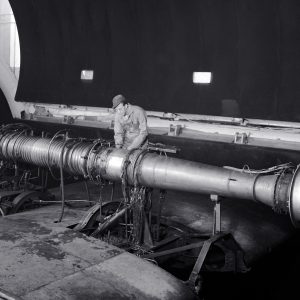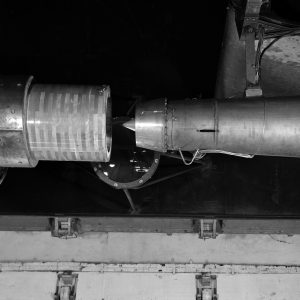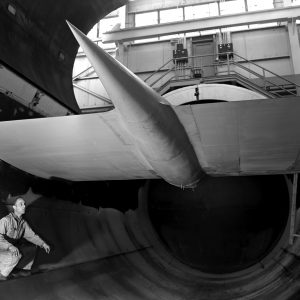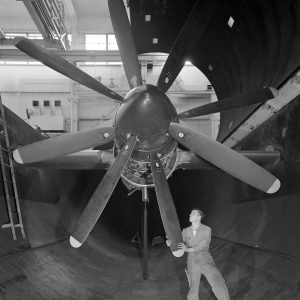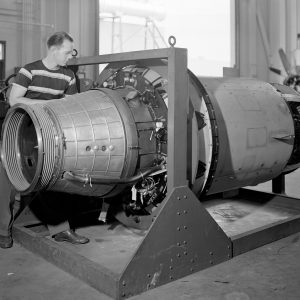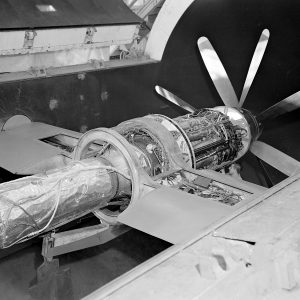Post-war Engines
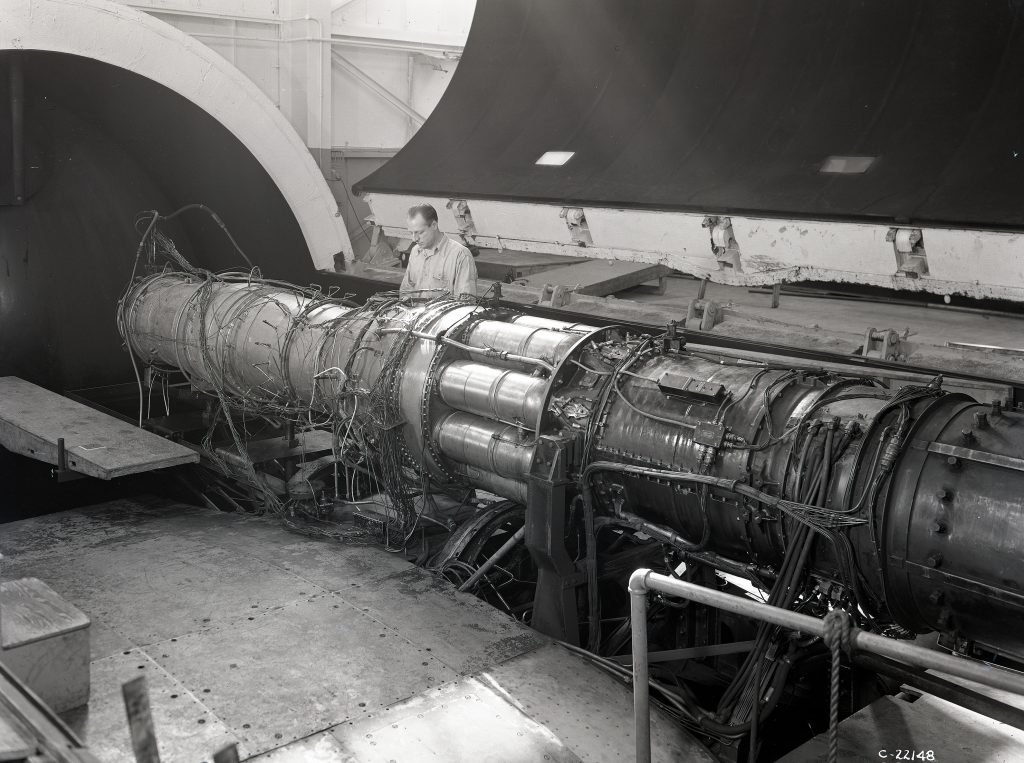
The AWT’s post-war testing and improvement of axial-flow turbojet engines was the facility’s most enduring contribution to the aerospace field.
Overview
With the end of World War II in the fall of 1945, the laboratory (renamed the Lewis Flight Propulsion Laboratory in 1948) underwent a major reorganization to focus on the new turbojet and missile technologies. The NACA upgraded the Altitude Wind Tunnel (AWT) several times during the 1940s and 1950s to keep up with the increasingly more powerful jet engines. For most investigations, the airflow was ducted directly into the engine inlets. NACA researchers conducted extensive testing of General Electric’s (GE) TG–180 and TG–190 and Westinghouse’s 24C and J40 during this period. They also studied other types of engines, including the turboprop and ramjet.
The AWT’s post-war research focused on the improving engine performance at high altitudes and refining components such as the afterburner. Researchers operated the engines over a range of altitudes, velocities, and engine speeds. Most AWT test programs first determined the engine’s performance and operating range at different altitudes. Researcher then attempted to introduce various modifications to improve the performance. The AWT’s most important contributions to the jet engines of this era involved restarting at high altitudes, afterburners and variable-area nozzles, and windmilling. The AWT contributed to a succession of advancements of jet engines that resulted in a tremendous surge in thrust capabilities in the late 1940s and early 1950s.
Documents
- AWT Investigations of Jet Engines (1945)
- NACA Inspection Talks on the AWT (1947)
- Comparison of Turbojet, Afterburner, and Ramjet in AWT (1947)
- Performance of Various Types of Aircraft Engines (1947)
- Full-Scale Engine Research in AWT (1951)
- Summary of NACA Research on Afterburners (1956)
First Modern Axial-Flow Turbojets
GE’s initial I–16 and I–40 turbojets employed centrifugal compressors, but the modern jet engine stemmed from the axial-flow compressor engines created simultaneously by the Westinghouse Corporation and GE’s Schenectady plant. Axial-flow compressor engines consisted of several stages of fan-like compressor blades arranged in line. Each stage increased the air pressure resulting in higher energy when ignited in the combustion chamber. Additional stages could be added to the axial-flow design to increase power without expanding the engine’s diameter.
General Electric TG–180 (J35)
GE’s Schenectady group had been considering using an axial-flow design for its TG–100 turboprop, when the military requested them to utilize the design for a turbojet in 1943. The resulting 11-stage TG–180 (J35) initially produced 3,750 pounds of thrust. The TG–180 powered the Bell X–5, Republic F–84 Thunderjet, Northrop F–89 Scorpion, and Douglas D–558 Skystreak.
During the mid-1940s, NACA researchers studied the TG–180 repeatedly in the AWT. The initial series in early 1945 is notable because it included the first firing of an afterburner in altitude conditions. Although the performance of this early version was marginal, the development of the afterburner proceeded rapidly, and it soon became standard on most jet engines. NACA experiments with various flame holders and fuel systems on the TG–180 led to significant improvements of high-altitude combustion. In addition, the investigators found that the rotation of compressor blades due to air flow rather than the turbine, as in the case of an engine stall, creates a tremendous amount of drag. This led to the implementation of retractable nacelle covers.
Documents
- AWT Investigation of TG–180 Thrust Augmentation (1948)
- Analysis of TG–180 Compressor Performance (1948)
- AWT Investigation of TG–180 Combustion Chamber (1948)
- Altitude Performance of Tailpipe Burner on TG–180 (1950)
Westinghouse 24C (J34)
Westinghouse designed the first U.S. axial flow engine, the 19A, and its successors the 19B and 19XB in the early 1940s. In 1944 the company began developing a new engine that would be better suited for twin-engine aircraft. This 3, 000 pound thrust 24C (J34) doubled the power of the 19B. Westinghouse began testing the engines in 1945 and by 1947 they began being incorporated into numerous aircraft including McDonnell’s XF–85 Goblin and F2h Banshee, as well as Douglas’s D–558-II Skyrocket and X–3 Stiletto.
In 1947, the NACA’s Lewis laboratory conducted an intensive examination of a X24C–4 in the AWT that analyzed general performance issues including operating range, acceleration, starting, and fuel consumption, but also analyzed specific components such as windmilling, combustion blowouts, and afterburner configurations. These tests were unique in that it was the only time the AWT was used for icing research. Nozzles in front of the engine sprayed water into the inlet to determine if ice buildup would cause the afterburner to overheat.
The Navy’s Vought F7u fighters were experiencing thrust problems with their 24C engines. In 1950, the Navy requested that the NACA test the 24C’s new automatic thrust controller in the AWT. The controller provided pilots with a single device that coordinated the operation of many of the aircraft’s mechanics, including the afterburner. The AWT permitted validation of predictive models and the study of the system with a full-scale engine in simulated altitude conditions.
Documents
- Operational Characteristics of Westinghouse X24C (1948)
- Performance and Windmilling Drag in X24C (1948)
- Inlet Icing and Hot-Gas Ice Protection of Turbojet (1948)
- Afterburner Operation of Electronic Regulator on XJ34 (1951)
- Investigation of XJ34 Engine without Electronic Controls (1953)
Next Generation Axial-Flow Engines
Westinghouse J40
Westinghouse developed its 11,000-pound-thrust J40 in the late 1940s to supersede its successful 24C (J34). The Navy sought to use the J40 to power its new McDonnell F3H Demon interceptor. The development was slow, however, and engine failures led to a series of crashes during early flights. In 1951, NACA researchers began an almost year long evaluation of the J40 in the AWT. They initially focused on reducing compressor surge levels. They found that the use of a mixer at the compressor outlet solved the surge issue.
This was followed by an overall evaluation of the modified engine that analyzed afterburners, engine restarting, and turbomachinery. After failing to adequately improve the J40’s thrust performance, Westinghouse canceled the program in 1955. McDonnell replaced the J40s with the more powerful Allison J71 engines, and the F3H Demon went on to become a successful aircraft.
Documents
- Altitude Operation of J40—WE-8 Turbojet Engine (1953)
- Altitude Investigation of Afterburners for J–40 Engine (1953)
- Effect of Blade Modifications on Compressor for XJ40 (1953)
- Investigation of High-Velocity Afterburners on J–71 (1954)
- Altitude Performance of J71–A-11 Engine (1956)
- J40 Performance with Hydrogen and JP–4 Fuels (1956)
General Electric TG-190 (J47)
The most successful of the United States’ post-war engines was GE’s TG–190 (J47). In the mid-1940s, GE engineers utilized new turbomachinery and lubrication systems to create an engine that produced significantly more power than the TG–180 despite having the same size inlet. The TG–190 powered Boeing’s B–47 and B–45, North American’s F–86A, and Convair’s B–36. In addition, the TG–190 became the first jet engine approved for commercial aircraft in the United States.
NACA researchers studied the TG-190s three times in the AWT between 1948 and the 1950s. In addition to analysis of general performance, they examined combustion chamber performance, high-altitude restarting, spark plug behavior, fuel distribution, and afterburner configurations. The researchers also investigated the effect of variable inlet-air velocity and the use of alternative jet fuels.
Documents
- Altitude Starting of J47 Turbojet Engine (1951)
- Investigation of AN-F-58 Fuel in J47 Engine (1949)
- Performance of Tailpipe with Variable Area Nozzle (1950)
- J47D Compressor, Combustor, Turbine Performance (1951)
Ramjet Engines
In the 1940s and 1950s, there was intense work on the development of ramjet engines for missile applications. Ramjets are among the simplest and most efficient propulsion systems, but their implementation poses many challenges. They cannot operate at low speeds, so they require another type of engine for their initial acceleration. Their performance at high speeds, however, was unrivaled by other airbreathing propulsion systems.
NACA-Designed Ramjets
In 1945, NACA engineers designed a 20-inch diameter ramjet engine to study the basic ramjet operation and improve its performance. They mounted the 12-foot long engine on a traditional wingspan in the AWT with the intake air piped directly to its inlet. This allowed the ram pressure ratio to be comparable to supersonic speeds while running in the subsonic AWT. Three series of runs conducted in 1945 and 1946 demonstrated that the engine’s performance increased sharply at supersonic speeds but losses in the supersonic diffuser slowed the rate of increase at higher Mach numbers.
Project Bumblebee
Meanwhile, in late 1944 the Navy asked the Applied Physics Laboratory at Johns Hopkins University to develop a ramjet-powered missile to thwart Japanese Kamikaze attacks. The war ended before the missile was operational, but the program, referred to as Project Bumblebee, continued throughout the 1940s. In 1947, the Navy asked Lewis to study the basic behavior of ramjets for this project. The effort involved flight tests, drops from aircraft, and combustion studies in the AWT.
The AWT investigations determined the optimal performance of an 18-inch diameter version using different types of flameholders. The researchers performed similar studies of a smaller 16-inch version of the engine during 1949. The lab’s Bumblebee investigations continued in the 1950s in the 8 by-6-foot and 10 by-10-foot supersonic wind tunnels.
Documents
- Ramjet Propulsion Talk (1947)
- Performance of 20-inch Ramjet at High Altitudes (1947)
- Ramjet Combustion Chamber Temperatures (1947)
- Bumblebee Project Semiannual Report (1949)
- Performance of Bumblebee Ramjet with Can Flameholder (1948)
- Comparison of Fuel Types in Bumblebee Ramjet (1948)
Turboprop Engines
The turboprop engine, which used a gas turbine engine to rotate a propeller, was one of the earliest schemes to use the gas turbine technology for aircraft propulsion. At the request of the Army, GE began development of the first US turboprop in 1941. Development of the resulting TG–100A engine was slow, however, and it was not flight tested until December 1945. The NACA gave the engine a thorough analysis in the AWT in late 1946. Researchers gathered data on basic engine performance over a range of altitudes. GE’s continued problems with the engine resulted in the military’s cancellation of the program in 1947 before incorporation into any production aircraft.
In 1949, the NACA acquired a Python turboprop engine with contra-rotating propellers from the British manufacturer Armstrong-Siddeley specifically for its researchers to study. The 14-stage Python powered the Wyvern torpedo bomber that was to be used by the Royal Air Force throughout the 1950s. In July 1949, the engine underwent evaluation in the AWT. After only single test run, the researchers were able to develop a frequency response method that used data from any specific altitude to predict the engine’s dynamic response characteristics at any other altitude.
Documents
- Altitude Investigation of TG–100A Turboprop Engine (1950)
- AWT Investigation of TG–100A Compressor-Turbine (1947)
- Altitude Performance of a Python Turboprop Engine (1952)
- Dynamic Investigation of Python Engine in AWT (1950)

